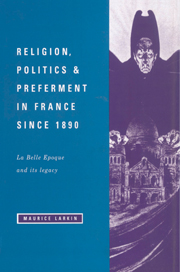Book contents
- Frontmatter
- Contents
- Preface
- Part 1 As it was: Catholics and the Republic, 1890–1914
- 1 Ralliés and dérailleurs: Catholics and subversion
- 2 Le sabre et le goupillon: Catholics and the Army
- 3 Raison d'état, raison d'église: the Roman dimension
- Part 2 As it was: Catholics and state employment, 1890–1914
- Part 3 As it became, 1914–1994
- Map: Religious observance in France, c. 1960.
- Notes
- Sources
- Index
2 - Le sabre et le goupillon: Catholics and the Army
Published online by Cambridge University Press: 27 January 2010
- Frontmatter
- Contents
- Preface
- Part 1 As it was: Catholics and the Republic, 1890–1914
- 1 Ralliés and dérailleurs: Catholics and subversion
- 2 Le sabre et le goupillon: Catholics and the Army
- 3 Raison d'état, raison d'église: the Roman dimension
- Part 2 As it was: Catholics and state employment, 1890–1914
- Part 3 As it became, 1914–1994
- Map: Religious observance in France, c. 1960.
- Notes
- Sources
- Index
Summary
Try as they might, the governments of Waldeck-Rousseau and Combes failed to establish conclusive links between Church figures and the antiRepublican conspiracies of the Dreyfus years. What was incontrovertible, however, was that many of the conspirators had been to Catholic private schools, as had a large proportion of their sympathisers. This could scarcely have been otherwise in a country where nearly 20 per cent of the entire male secondary-school population in 1898 were taught in schools run directly or indirectly by religious orders – while a further 22 per cent attended other Catholic schools. To keep matters in perspective, only 5 per cent of French children received secondary education of any sort at that time; but these included a large proportion of the men who were to occupy positions of responsibility in the Army and Civil Service. It was alarming to Republicans that so large a minority of this elite was passing through the hands of ‘celibate fanatics, brimful of political hatred and sexual frustration’. Yet the fact that the minority greatly outstripped the proportion of practising Catholics in the circles from which they came indicated that the benefits that many parents were seeking for their sons were social and ‘character-forming’ rather than specifically religious. Secularists reacted to this consideration in ambivalent fashion. It was reassuring on the one hand that 42 per cent of secondary schoolboys were not necessarily clerical dragon's teeth, impatiently counting the days until they could combat the government through the ballot box or stab it in the back by infiltrating the Army and the Civil Service.
- Type
- Chapter
- Information
- Religion, Politics and Preferment in France since 1890La Belle Epoque and its Legacy, pp. 29 - 52Publisher: Cambridge University PressPrint publication year: 1995

